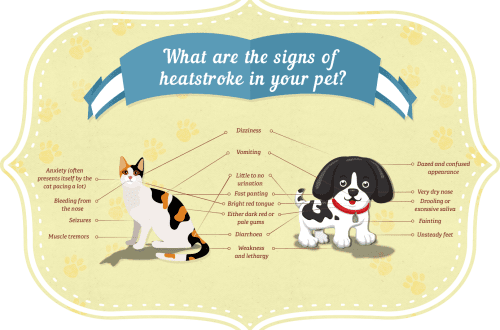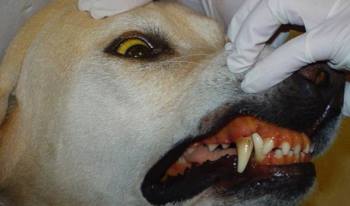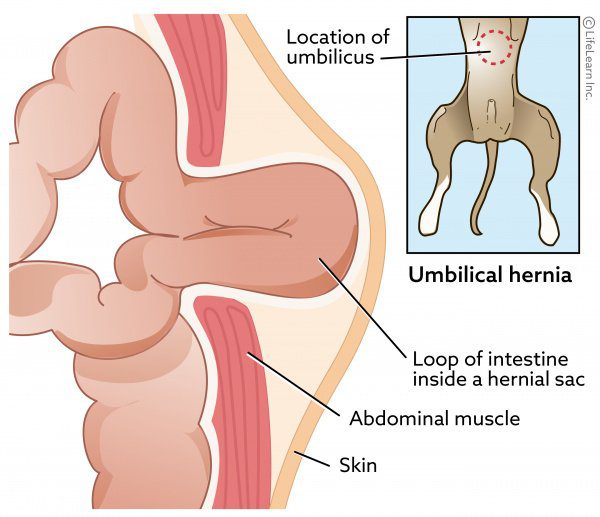
Hernias in dogs
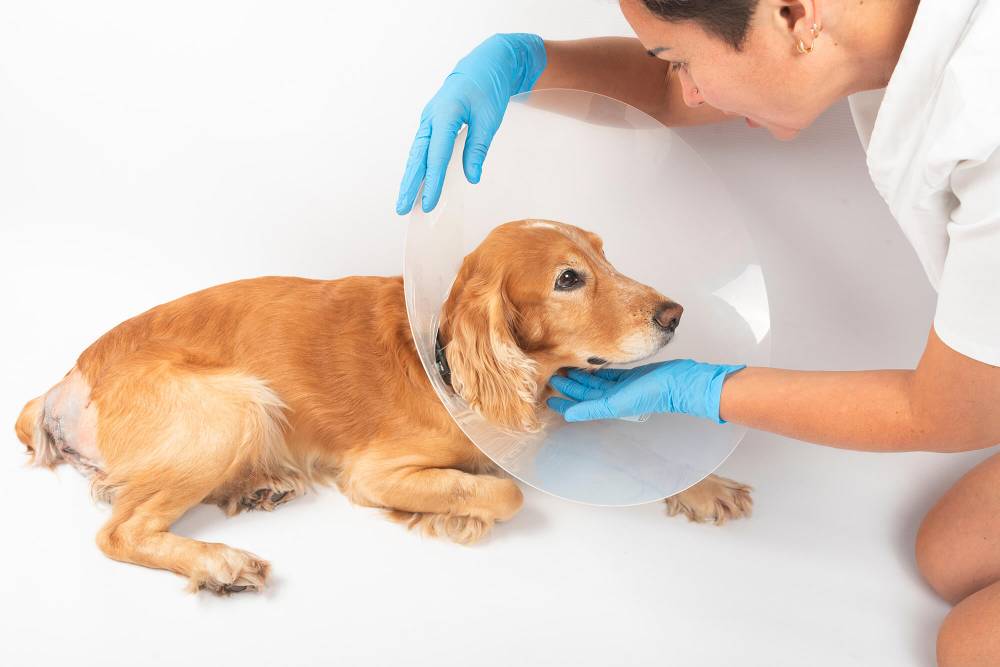
Most often, hernias occur in dogs, there is no sexual predisposition. There are breed characteristics: for example, dachshunds more often than other dogs suffer from intervertebral hernias.
Contents
Causes of appearance
All types of hernias are divided into congenital and acquired. In the causes of the development of congenital hernias, hereditary factors may play a role. Acquired hernias, as a rule, are the result of injuries (diaphragmatic hernia), some kind of extreme overstrain (inguinal hernias) or arise as a result of structural features of the musculoskeletal system and load on the spine (intervertebral hernias).
Symptoms
Symptoms of a hernia depend on its location and the presence of complications. Congenital hernias are most often asymptomatic, we can only notice an unusual bump in the animal (for example, with an umbilical hernia – in the umbilical region) or not detect any defects at all (with a diaphragmatic hernia). Such a hernia, as an intervertebral one, is an orthopedic pathology and is manifested by severe pain when walking and exerting.
Types and features of the location of hernias
Depending on the location, the following types of hernias are noted:
- umbilical hernia;
- inguinal hernia;
- diaphragmatic hernia;
- intervertebral hernia.
Next, we will analyze in more detail the features of each of the listed hernias.
Hernia on the abdomen (umbilical)
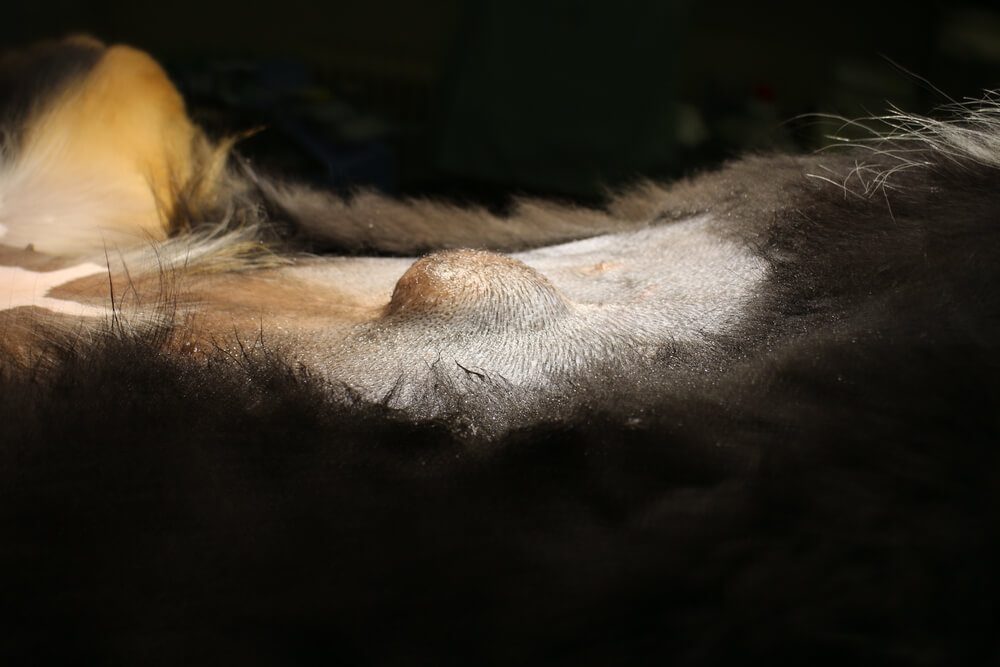
Photo of an umbilical hernia (also found in puppies)
An umbilical hernia in dogs is a pathological opening in the abdominal wall near the navel, through which the hernial sac protrudes (usually containing the omentum, but sometimes the intestines). As a rule, a hernia on the abdomen in a dog is unrepairable and requires surgical treatment. In some cases, such as a small formation, doctors recommend monitoring the hernia: if the puppy is lucky, then the hernia will not increase in size with age and it can not be operated on.
Inguinal hernia
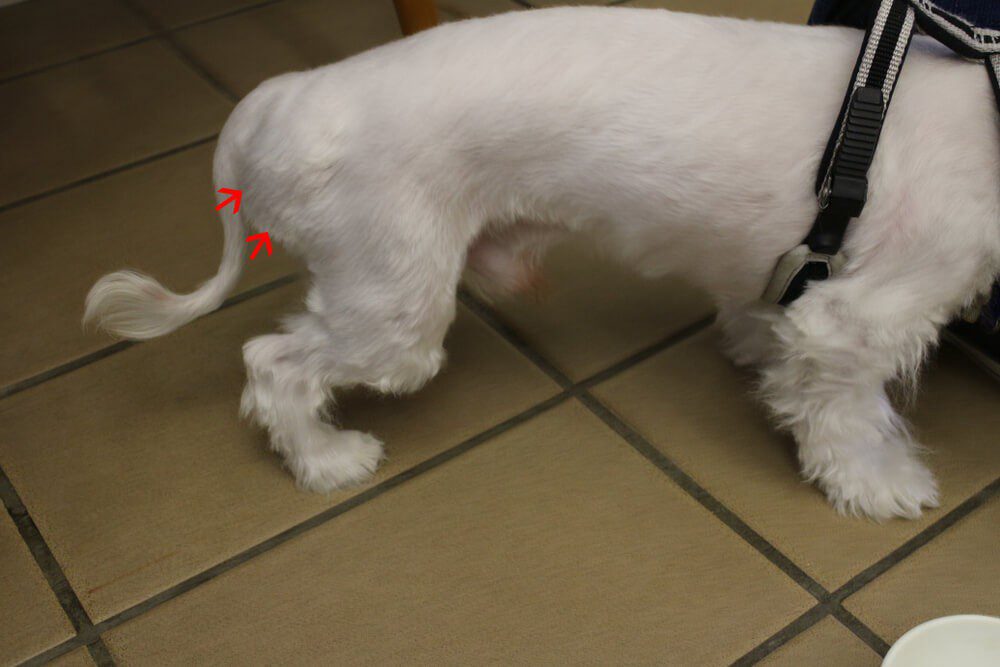
An inguinal hernia in a dog is a condition where the abdominal organs prolapse through a wide inguinal canal or inguinal ring. A hernia in a dog in the groin can be formed either as a result of a congenital pathology (an excessively large inguinal ring – this pathology is hereditary!), Or as a result of injury or overstrain / weakening of the muscles of the abdominal wall (for example, in pregnant bitches).
Inguinal hernias are divided into:
- reducible;
- unguided;
- disadvantaged.
Reducible inguinal hernia is a protrusion of the type of subcutaneous tumor in the inguinal region (on one side or symmetrical bilateral), which can appear and disappear. With an uncontrolled formation, the protrusion does not go anywhere; in most cases, an increase in the size of the formation is characteristic. With a strangulated hernia, the pet will experience acute signs of pain, colic, and may not be able to go to the toilet.
Inguinal hernias are dangerous because, in addition to the omentum, vital organs can get into the hernial sac: uterus, intestines, bladder.
A strangulated hernia is very dangerous for the health and life of a pet: the organs not only enter the inguinal canal, but are also infringed, squeezed by the walls of the hernial sac, twisted, as a result of which the blood supply is disrupted and tissue necrosis can occur, that is, necrosis of the organ. Symptoms of a strangulated inguinal hernia include:
- vomiting;
- acute pain;
- frequent attempts to urinate;
- the presence of blood in the urine;
- lack of appetite;
- oppressed state.
This condition requires emergency surgery.
perineal
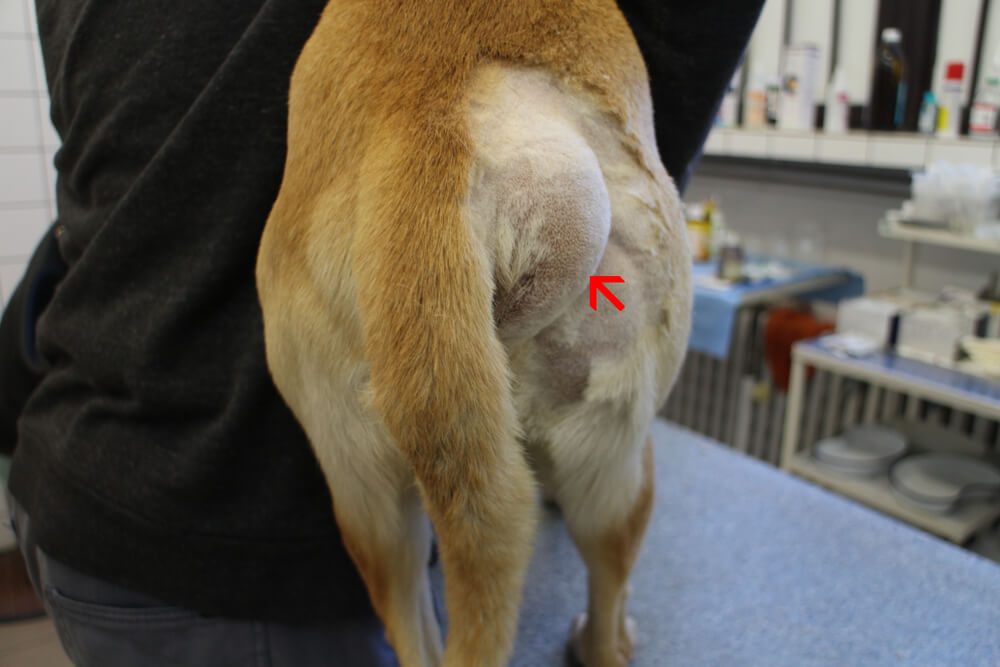
It is important to distinguish an inguinal hernia from a perineal hernia. A hernia of the perineum is a prolapse of the omentum, retroperitoneal tissue or pelvic organs through a defect in the pelvic diaphragm. This pathology has a gender and age predisposition: most often it occurs in males (in 95% of cases), usually older than five years. There are also predisposed breeds – these are boxers, collies and Pekingese. Unfortunately, the cause of this disease is unknown, therefore, hereditary factors in the development of pathology are suggested. It is believed that congenital weakness of the muscular system of the pelvis, as well as diseases of the prostate gland, chronic constipation and diseases of the rectum, can lead to a perineal hernia.
Diagnosis is based on clinical signs. The main symptom of a perineal hernia is a tumor-like formation of a soft structure in the perineum, it can be either unilateral or symmetrical bilateral. To clarify the diagnosis, an abdominal ultrasound and/or abdominal x-ray with contrast is recommended.
Like inguinal hernia, perineal hernia is treated only surgically.
Diaphragmatic
Diaphragmatic hernia is the penetration of the abdominal organs into the chest cavity through a pathological (congenital or acquired) hole in the diaphragm.
Diaphragmatic hernia is often a complication of trauma (falls from a height, car accidents, penetrating wounds, blunt abdominal trauma), is a life-threatening condition and therefore requires early diagnosis and surgical treatment. At the same time, congenital diaphragmatic hernia, on the contrary, may not cause any concern to the pet and be an accidental finding during a plain x-ray or ultrasound of the abdominal cavity.
Symptoms of a diaphragmatic hernia include:
- shortness of breath;
- breathing with an open mouth;
- abdominal type of breathing;
- occasionally there may be a cough.
The following organs can enter the hernial canal from the abdominal cavity into the chest:
- liver;
- small intestine;
- stomach;
- spleen;
- stuffing box;
- pancreas;
- rarely – the large intestine and even the pregnant uterus.
The severity of a diaphragmatic hernia in dogs is associated both with the difficulty in the normal functioning of the heart and lungs (they are compressed by hernial contents), and with the difficulty in the work of the abdominal organs that have fallen into the chest, which leads to congestion in them and even necrosis (tissue death).
The main methods for diagnosing this pathology include:
- Ultrasound of the abdominal cavity;
- x-ray of the chest and abdominal cavity with the introduction of contrast agents;
- in complex cases, CT is used – computed tomography.
Intervertebral
Intervertebral hernia in dogs is one of the most common diseases in the spinal cord, leading to severe pet discomfort. Predisposed breeds are middle-aged or older dachshunds, as well as Pekingese and Shih Tzu. Sexual predisposition is not noted.
To make a diagnosis, apply:
- myelography;
- computed tomography (CT), MRI;
- CT myelography (combination of the above two methods).
Unfortunately, x-rays are an undesirable diagnostic method, since this pathology can very rarely be detected on x-rays of the spine.
There are intervertebral hernias of the first and second types. Type XNUMX hernias are much more common and result in compression of the spinal cord, resulting in severe neurological damage to the dog. Hernias of the second type are a rarer pathology, they are difficult to diagnose pathology and may not lead to pronounced clinical symptoms.
Treatment of these pathologies is only surgical intervention.
Hernia Treatment in Dogs
As mentioned earlier, the treatment of a hernia is carried out only through surgical intervention. Before the operation, it is mandatory to conduct a complete examination of the pet (general and biochemical blood tests, ultrasound of the heart and abdominal cavity) both to assess the scale of the surgical intervention and to assess the anesthetic risks. The operation is performed at any age and only under anesthesia.
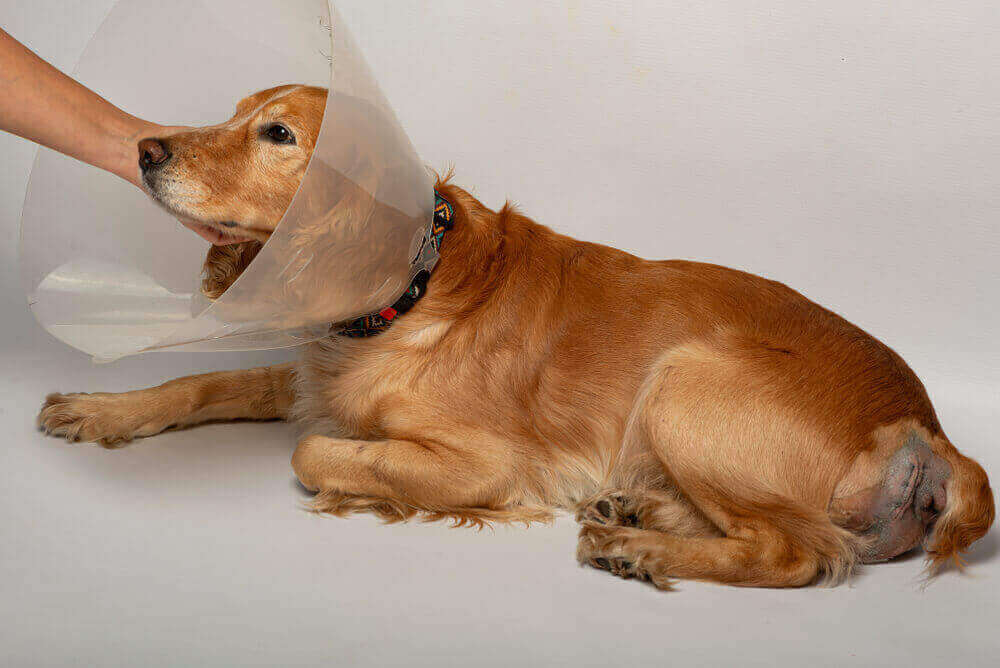
Hernia removal
Before removing the hernia, the doctor necessarily examines the hernial opening, if possible, returns the fallen organs to the abdominal cavity, making sure that they are intact. If there was an infringement of the organs and some part of them underwent necrosis, this area must be removed. After that, the hernial opening is sutured.
With timely treatment to the clinic, the operation does not take much time, the prognosis for recovery is favorable. In advanced cases, when infringement and disruption of the prolapsed organs have already occurred, the prognosis will depend on the speed of contacting a doctor, the characteristics of the course of the pathology and the individual characteristics of the dog.
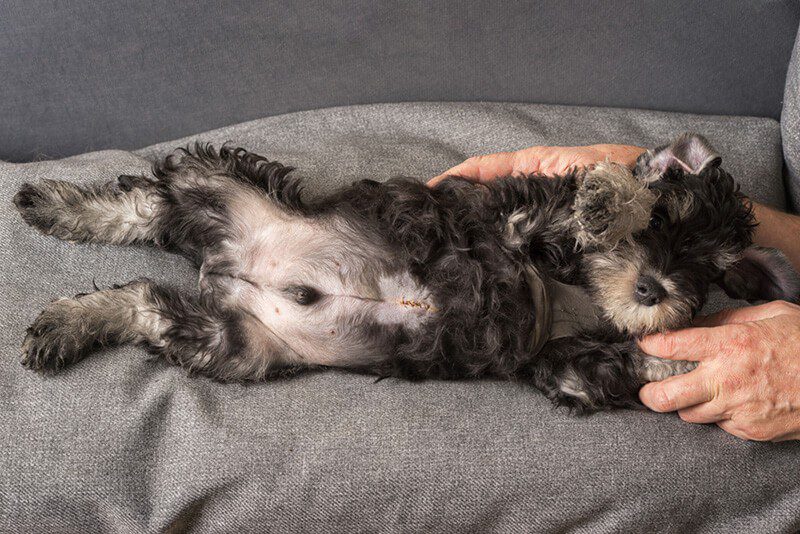
Treatment of hernia in puppies
The peculiarities of the treatment of hernias in puppies include the small age of the patient and the expediency of the operation. Most often, a hernia on the abdomen is noted in puppies, and depending on its size and the results of ultrasound, the doctor decides on the advisability of emergency or planned surgical intervention. In cases of a small umbilical hernia in a puppy and no health complaints, in many cases the doctor recommends waiting with the operation for at least 6-8 months – just at this age, the pet can already undergo castration surgery and it will be possible to combine two operations. If the puppy has an inguinal hernia, on the contrary, it is recommended to perform the operation as soon as possible after its discovery.
The indication for emergency surgery is the localization of the hernia, clinical symptoms (soreness, inconvenience for the puppy, strangulation of the hernia) and the size of the formation.
Preventive measures
Hernia prevention includes:
- non-admission to breeding pets who had a hernia, as there is a hereditary pattern of their development;
- injury prevention;
- it is advisable to examine pets at the veterinarian once a year, to do an ultrasound of the abdominal cavity to exclude the presence of hidden internal pathologies.
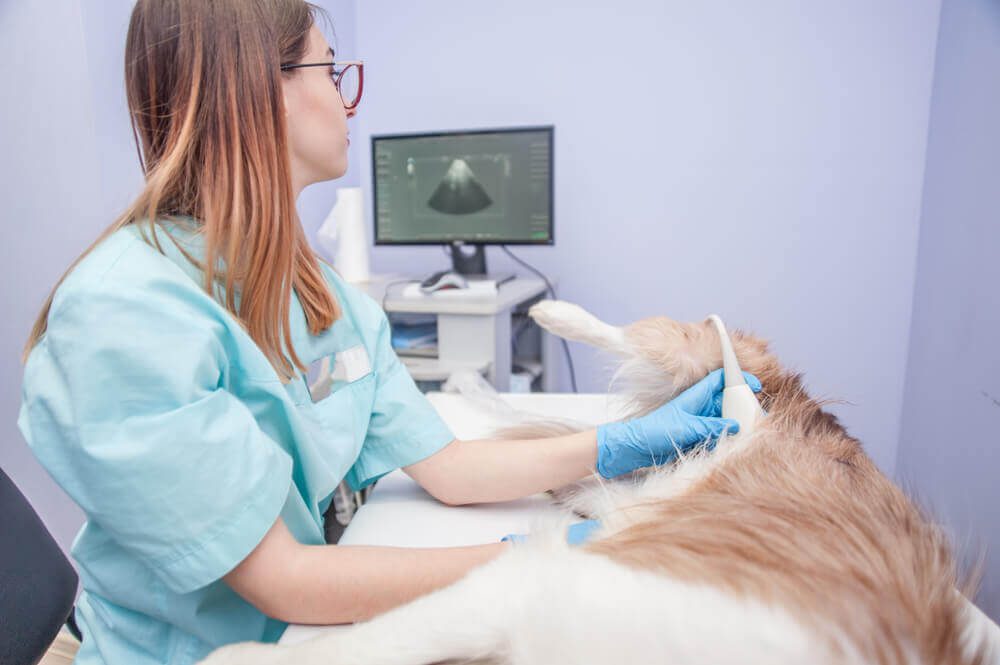
The article is not a call to action!
For a more detailed study of the problem, we recommend contacting a specialist.
Ask the vet
October 5 2020
Updated: February 13, 2021



